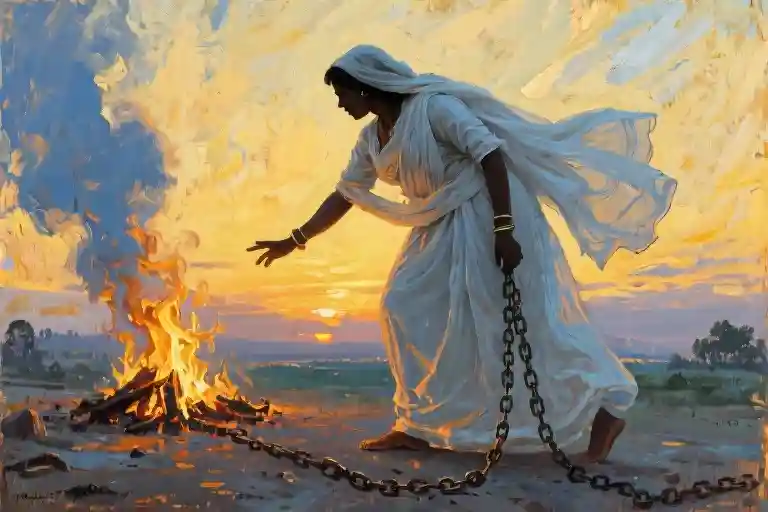The streets of Kolkata smell of marigolds and burning camphor during Durga Puja, while in New Delhi’s parliament house, women in crisp cotton saris debate agricultural subsidies. This is the paradox of modern India – a land where marble goddesses receive daily offerings of vermilion and coconuts, yet the National Crime Records Bureau reports a rape every 16 minutes. How does a civilization that worships its rivers as goddesses and personifies the nation as Bharat Mata reconcile such contradictions?
Consider these numbers: India elected its first female prime minister in 1966, decades before most Western nations, yet ranks 135th in global gender gap indexes. Over 61% of Hindu temples are dedicated to goddesses, while certain shrines still bar menstruating women. The same hands that string jasmine garlands for Durga’s idols sometimes hesitate to promote women in corporate boardrooms.
This tension between divine femininity and earthly gender dynamics forms the core of India’s cultural DNA. The Shakti tradition – worship of feminine cosmic energy – isn’t merely about ritualistic idol veneration. It’s a sophisticated philosophical system that shaped subcontinental thought for millennia, influencing everything from classical dance forms to constitutional frameworks. When Indira Gandhi was hailed as ‘Durga incarnate’ during the 1971 war, the metaphor resonated because Indians instinctively understand power through goddess imagery.
Yet modern applications of this ancient symbolism reveal fascinating complexities. Why do female politicians alternate between projecting maternal warmth and warrior fierceness? How does Kali’s terrifying form, with her necklace of skulls, inform contemporary discussions about feminine rage? The answers lie in unpacking three interconnected layers: the metaphysical concepts of Shakti, their mythological manifestations, and their translation into modern socio-political vocabulary.
Morning prayers at Chennai’s Kapaleeshwarar Temple illustrate this continuum. Office workers queue to place laptops before Saraswati, the knowledge goddess, before heading to tech parks. In Mumbai, stock traders whisper mantras to Lakshmi while monitoring Sensex fluctuations. These aren’t superficial rituals but evidence of a living philosophy where the divine feminine mediates between spiritual and material realms. The real story isn’t in the apparent contradiction between goddess worship and gender disparities, but in how this tradition continuously adapts to new contexts while retaining its essential grammar of feminine power.
The Grammar of Cosmic Energy: Three Principles of Shakti Philosophy
The concept of Shakti pulses through Hinduism like a living current, far more than a theological abstraction. This primal feminine energy manifests in ways that continue to shape Indian consciousness, from ancient palm-leaf manuscripts to contemporary boardrooms. Understanding Shakti requires peeling back layers of meaning that have accumulated over millennia.
At its core, Shakti represents the dynamic principle of the universe – not merely power, but the very capacity for existence itself. The Rig Veda’s hymns to Vak, the goddess of speech, reveal early traces of this philosophy. When the text declares \”I gave birth to the father,\” it establishes language not just as communication but as generative matrix. Modern linguists might recognize here an uncanny anticipation of how language shapes reality.
Tantric traditions took this further through the yoni symbolism – not simply biological representation but a geometric diagram of cosmic potential. The triangular form appears in temple architecture and meditation diagrams, mapping the intersection of material and spiritual planes. Contemporary physicists studying quantum vacuum fluctuations might appreciate how closely these ancient models resemble their descriptions of latent energy fields.
Yet Shakti philosophy resists neat categorization. The same tradition that venerates creative power through Lakshmi also embraces destructive transformation through Kali. This duality surfaces in unexpected places – like the way Indian classical dance alternates between lasya (graceful) and tandava (forceful) movements, or how monsoon clouds bring both life-giving rain and devastating floods.
The modern scientific community remains divided about gendering cosmic principles. While some cognitive linguists note how language structures influence perception of abstract concepts, others caution against projecting human categories onto natural phenomena. This tension mirrors ongoing debates within India about interpreting ancient symbols through contemporary feminist frameworks.
What emerges is not a monolithic doctrine but a living conversation across centuries. When a software engineer in Bangalore lights a lamp for Saraswati before coding, or when a social activist invokes Durga’s fearlessness during a protest, they’re participating in this continuum. The brilliance of Shakti philosophy lies in its capacity to hold multiple truths simultaneously – much like the goddess herself, who in some traditions is described as having three eyes: one for creation, one for preservation, and one for dissolution.
The Divine Job Description: How Hindu Goddesses Mirror Modern Professions
The pantheon of Hindu goddesses presents something remarkable – a celestial HR department where each deity holds distinct responsibilities, wields specialized tools, and remarkably, corresponds to contemporary professional archetypes. This isn’t mere mythology; it’s an ancient system of cosmic role allocation that continues influencing workplace culture today.
Consider Saraswati, the goddess of knowledge, seated serenely upon a white lotus with her veena (string instrument) and scriptures. Her modern counterparts? The coding wizards of Bangalore’s tech parks and Chennai’s IT corridors where programmers often keep small Saraswati statues on their desks. There’s quiet poetry in watching a developer debugging complex algorithms while sunlight glints off a miniature bronze veena – a twenty-first century puja (worship) performed with keyboards instead of flower offerings.
Lakshmi’s domain reveals another fascinating parallel. The golden-complexioned goddess of prosperity, often depicted showering coins from her lotus-held hands, finds her contemporary manifestations in Mumbai’s stockbrokers and startup founders. The traditional diya (oil lamp) lit during Diwali to invite Lakshmi into homes now shares shelf space with Bloomberg Terminal screens in affluent households. Modern financial advisors have unconsciously adopted Lakshmi’s iconography – their PowerPoint presentations filled with golden upward trend graphs mimicking her coin-showering posture.
Then comes Kali, the ultimate disruptor. With her wild hair, garland of skulls, and tongue protruding in fierce determination, she’s the patroness of necessary destruction. Today’s corporate turnaround specialists and crisis managers channel Kali’s energy when restructuring failing companies. The goddess who dances on Shiva’s inert body would likely approve of modern management strategies that dismantle outdated systems to allow rebirth. Those dramatic office clear-outs where obsolete files get shredded? That’s Kali energy at work.
What makes this divine-professional mapping particularly relevant is how consciously Indians engage with it. During exam seasons, Saraswati’s shrines overflow with student offerings. Financial year-ends see Lakshmi temples crowded with accountants. And when radical change is needed? That’s when Kali’s fierce statues get polished up for special prayers. The goddesses aren’t distant mythological figures but active participants in India’s professional landscape.
Chennai’s IT district offers a living case study. Walk into any tech company cafeteria during lunch breaks, and you’ll spot groups of young professionals debating whether to visit the nearby Saraswati temple after work. Their reasoning is surprisingly pragmatic: “When debugging gets tough, the goddess helps me see patterns,” one developer confessed while tapping his forehead. Another admitted keeping Saraswati as his laptop wallpaper because “her veena reminds me that coding is creative work, not just logic.”
This seamless integration of ancient archetypes with modern workspaces reveals Hinduism’s unique approach to the sacred-professional divide. Unlike traditions that separate spiritual life from daily work, the goddess tradition suggests all labor contains divine essence. The accountant’s spreadsheet and the programmer’s algorithm become contemporary yantras (sacred diagrams), their practitioners unknowingly participating in an eternal cosmic workforce where Saraswati oversees the knowledge sector, Lakshmi manages financial flows, and Kali supervises organizational change.
The implications extend beyond individual practice to corporate culture itself. Many Indian companies consciously incorporate goddess symbolism during important transitions. A Mumbai investment firm begins fiscal years with Lakshmi pujas. A Delhi tech startup stages dramatic Kali-themed rebranding events when pivoting their business model. These aren’t empty rituals but psychological anchors connecting modern professionals to deep cultural templates of feminine power and competence.
Perhaps what’s most striking is how these ancient goddess archetypes anticipate modern workplace needs. Long before Silicon Valley coined terms like “disruptive innovation” or “knowledge economy,” Hindu tradition had already personified these concepts as divine feminine energies. The goddesses don’t just mirror modern professions – they provide a spiritual framework for understanding professional life itself as sacred activity.
The Mother on the Flag: Political Theology of National Personification
A chromolithograph from 1905 shows her for the first time – Bharat Mata standing serene in saffron robes, four arms holding scriptures, sheaves of rice, a white cloth, and rudraksha beads. This wasn’t merely artistic imagination but the crystallization of a nation’s subconscious. The weapons would come later, as would the lion mount and the map-shaped halo, but the essential alchemy was complete: a land had become a goddess.
What happens when an ancient goddess archetype gets drafted into modern nation-building? The visual grammar of Bharat Mata paintings reveals telling evolutions. Early 20th century renditions emphasized nourishment and wisdom (those rice sheaves and Vedas), while wartime posters during the 1971 conflict showed her brandishing a trident like Durga. The most recent digital artworks often depict her emerging from a lotus – the BJP’s electoral symbol – wearing a bulletproof vest. Every iteration serves its historical moment while maintaining the core paradox: a maternal figure who must simultaneously nurture and destroy.
B.R. Ambedkar saw the danger in this metaphor early. As the principal architect of India’s constitution, he warned against conflating spiritual motherhood with civic citizenship. His objections weren’t to goddess worship per se, but to how the Bharat Mata construct could mask real inequities. When a nation gets envisioned as a sacred female being, does that actually elevate living women or simply create another layer of symbolic appropriation? The constitutional debates of 1947-50 show fascinating tensions between preserving Hindu cultural idioms and establishing secular governance.
Consider Article 42’s mandate for maternity benefits – at first glance, a straightforward labor protection. Read alongside the Devi Mahatmya’s verses about the cosmic womb, it takes on additional resonance. Or examine how the Prevention of Insults to National Honor Act (1971) prohibits Bharat Mata’s depiction in ‘undignified ways,’ creating legal protections no living woman enjoys. The goddess-nation metaphor operates in this liminal space between spiritual ideal and political instrument.
Perhaps the most revealing tension appears in educational contexts. Schoolchildren across India sing ‘Vande Mataram,’ its lyrics fusing territorial devotion with goddess imagery (‘Sujalam suphalam’ praising the land’s bounty like a mother’s gifts). Yet the same classrooms often segregate girls during menstruation, enacting the very taboos denied at major goddess temples. This cognitive dissonance – between symbolic veneration and biological regulation – forms the central fault line of India’s gendered nationalism.
The ongoing judicial battles tell the story best. In 2018, the Supreme Court ruled that temple traditions couldn’t override constitutional equality, allowing women of all ages to enter Sabarimala. The backlash was immediate and violent, with protesters invoking the ‘sanctity of divine motherhood.’ Here lies the metaphor’s double edge: when a nation gets worshipped as goddess, which aspects of her power get celebrated versus contained? The nurturing bosom or the bloodied fangs? The creative yoni or the disciplinary noose?
Modern politicians navigate this minefield with calculated symbolism. Female MPs often take their oaths wearing the sindoor and mangalsutra of married goddesses, while avoiding Kali’s more radical iconography. Male leaders invoke Lakshmi’s blessings during economic reforms but sidestep her association with wealth redistribution. Even the parliamentary calendar unconsciously mirrors the Navratri festival cycle, with major bills often introduced during the goddess-focused autumn session.
As digital nationalism rises, new questions emerge. Does a viral #BharatMataKiJai tweet carry the same sacral weight as a temple mural? Can AI-generated goddess imagery (already appearing in some political campaigns) retain the shakti of hand-sculpted murtis? The answers may determine whether this century-old metaphor can survive its own contradictions – or if India needs new symbols for its evolving democracy.
The Sari Politics of Power: Decoding Contemporary Leadership Symbols
The crimson border of a politician’s sari often carries more weight than policy documents in India’s political theater. When Indira Gandhi appeared on national television during the 1971 war, her carefully draped handloom sari wasn’t just traditional attire – it became a visual mantra invoking Durga’s protective might. This strategic deployment of Shakti symbolism reveals how India’s female leaders navigate the tightrope between divine archetypes and democratic governance.
The Durga Paradox: Indira’s Emergency and the Kali Backlash
Political analysts still debate whether Gandhi’s 1975 Emergency declaration mirrored Durga’s righteous fury or Kali’s destructive aspect. State-controlled media outlets deliberately used Durga imagery during this period, with cartoonists depicting the prime minister wielding multiple arms holding governance tools instead of weapons. Yet as civil liberties eroded, opposition newspapers began invoking Kali’s terrifying form – complete with skull garlands and wild hair – to critique authoritarian overreach.
This duality persists in modern campaigns. West Bengal Chief Minister Mamata Banerjee’s trademark white cotton sari with red border consciously echoes the minimalist aesthetic of rural Kali worshippers, while Delhi’s female MPs often choose the golden zari work associated with Lakshmi during budget debates. The colors aren’t accidental – they’re sartorial semiotics whispering to constituents’ subconscious.
Subaltern Shakti: Dalit Women Reclaiming Warrior Symbols
When Mayawati, the Dalit leader from Uttar Pradesh, commissioned statues of herself holding a purse and constitution, she was rewriting Durga’s iconography for marginalized communities. Traditional depictions show the goddess holding weapons gifted by male gods, but these modern interpretations present administrative tools as empowerment symbols. During election rallies, Bahujan Samaj Party workers distribute miniature statues where the trident transforms into a pen – a quiet revolution in symbolic vocabulary.
The most fascinating transformations occur at street level. In Tamil Nadu’s local elections, Dalit councilors have adapted the kumkum forehead mark – traditionally denoting married Hindu women’s auspiciousness – into a political statement by applying it in geometric patterns resembling warrior tilaks. These aren’t merely cosmetic choices but tactical negotiations with centuries of symbolic hierarchy.
The Price of Divine Parallels
Such symbolism carries risks. When a prominent female minister compared herself to Kali while announcing strict economic reforms, opposition leaders weaponized the analogy, questioning whether human leaders should appropriate divine wrath. The controversy revealed the delicate balance required when mixing sacred metaphors with secular governance – the same Shakti that empowers can also scorch those wielding it carelessly.
Perhaps this explains why contemporary leaders increasingly favor Saraswati’s intellectual symbolism over warrior goddess imagery during policy announcements. The veena (lute) makes for gentler optics than a bloodied sword, though both represent forms of Shakti. As India’s political language evolves, so does its symbolic toolkit – where every fold of a sari and choice of jewelry communicates volumes about which aspect of the divine feminine a leader chooses to channel.
The Contradictory Sanctum: Shakti’s Modern Dilemmas
The chanting of Sanskrit mantras still echoes through the stone corridors of Kerala’s Attukal Bhagavathy Temple, where a quiet revolution unfolds each morning. Young women in crisp white saris now perform rituals that were exclusively male domains just a decade ago. This scene captures the central paradox of contemporary Shakti worship – ancient traditions colliding with modern gender politics in ways that would make Kali herself smile.
In 2018, the Supreme Court’s landmark verdict lifting the ban on women priests created shockwaves beyond Kerala’s palm-fringed temples. The ruling didn’t simply grant access; it challenged centuries of scriptural interpretation regarding menstrual impurity. Traditionalists cited the 11th century Aparaarkasmriti text prohibiting menstruating women from touching idols, while reformers pointed to Rig Veda hymns celebrating women seers like Lopamudra. The real battleground wasn’t just about ritual purity, but about who gets to define Shakti’s contemporary expression.
Cinema screens tell parallel stories of reinterpretation. When Deepika Padukone’s Padmavati transformed into a goddess-like figure engulfed in flames, audiences didn’t just see a Rajput queen’s sacrifice. The visual language deliberately mirrored Durga’s victory over Mahishasura, with the actress’s smoldering gaze becoming a Rorschach test for modern feminism. Bollywood’s goddess imagery now serves as cultural shorthand – a heroine’s slow-motion hair flip recalling Parvati’s wrath, or a politician’s fiery speech edited with Kali’s tongue-wagging idol cuts.
These tensions reveal Shakti’s living paradox. The same society that elects women chief ministers still debates whether menstruating devotees can enter Sabarimala. College students invoking Saraswati during exams might simultaneously dismiss temple traditions as patriarchal. Perhaps this isn’t hypocrisy but Hinduism’s enduring capacity for cognitive dissonance – the ability to hold contradictory truths about feminine divinity and human women in simultaneous tension.
What emerges isn’t neat resolution but fascinating hybrid practices. In Chennai’s IT corridors, programmers install digital Saraswati shrines with LED diyas. Delhi’s female MPs consciously alternate between Durga’s warrior imagery and Lakshmi’s nurturing symbols depending on political context. The goddesses aren’t being discarded but disassembled like cosmic Lego, their attributes recombined for 21st century needs.
This ongoing negotiation suggests Shakti worship was never meant to be monolithic. The tradition’s genius lies in its inherent flexibility – Kali can be bloodthirsty demon-slayer and cosmic mother within the same hymn. Today’s challenges simply extend that elastic quality from mythology into social practice. When teenage girls in Mumbai slums draw strength from Durga posters while fighting for school access, they’re participating in the same living tradition that once inspired queens to build temples.
The real test may come when artificial intelligence enters this sacred ecosystem. How will algorithms interpret Kali’s paradoxical nature? Can chatbot priestesses convey Shakti’s primal energy? These questions sound futuristic until you notice tech workers already placing roses on their laptops like miniature puja offerings. The goddess has always adapted to new mediums – from palm-leaf manuscripts to television serials. Her next avatar might surprise us all.
When Algorithms Meet the Divine: Reimagining Shakti in the Digital Age
The scent of marigold garlands and ghee lamps lingers in the air as a priest performs arati before the stone murti of Kali. Three time zones away, a neural network generates pixel-perfect renditions of the goddess with ruby lips and cosmic eyes. This collision of ancient worship and artificial intelligence forces us to ask uncomfortable questions about how we define sacred feminine energy when the boundaries between carbon and silicon blur.
Shakti has always been fluid in her manifestations – from the nurturing Parvati cradling baby Ganesha to the blood-drinking Chamunda dancing on corpses. Her adaptability across millennia suggests she might comfortably inhabit our digital ecosystems. Yet something prickles beneath the skin when we consider Bangalore tech parks hosting pujas for AI-generated goddess icons. Is this continuity or sacrilege?
Five Civil Observation Points for Navratri in the Algorithmic Era
1. Follow the Flowers
Notice how fresh hibiscus offerings at neighborhood Kali temples contrast with the immortal digital garlands on metaverse shrines. The wilting petals teach impermanence – a lesson that glitch-proof holograms struggle to convey.
2. Decode the Dance
Traditional Tandava movements embody destruction’s rhythm. Watch how VR headsets translate this into motion-captured data points, then ask what gets lost when a devotee’s spontaneous tremble becomes trackable metrics.
3. Taste the Prasad
The gritty sweetness of boondi ladoo distributed at Durga pandals carries generations of kitchen alchemy. Compare this to NFT-based prasadam tokens – both are acts of faith, but only one nourishes the microbiome of community.
4. Measure the Silence
Time the pause between temple bells during aarti, then listen to the artificial intervals of meditation apps. The imperfections in human-created silence contain their own divinity.
5. Track the Shadows
Observe how oil lamps cast flickering goddess silhouettes on temple walls versus the sterile glow of LED diyas. The play of light and dark mirrors our struggle to preserve Shakti’s mysterious essence in an age of total illumination.
Perhaps the question isn’t whether AI can comprehend Shakti, but whether we’ve forgotten how to recognize her in forms that don’t fit our programmed expectations. As you walk through the neon-lit pandals this Navratri, carry this thought: the goddess never feared transformation – she invented it.





